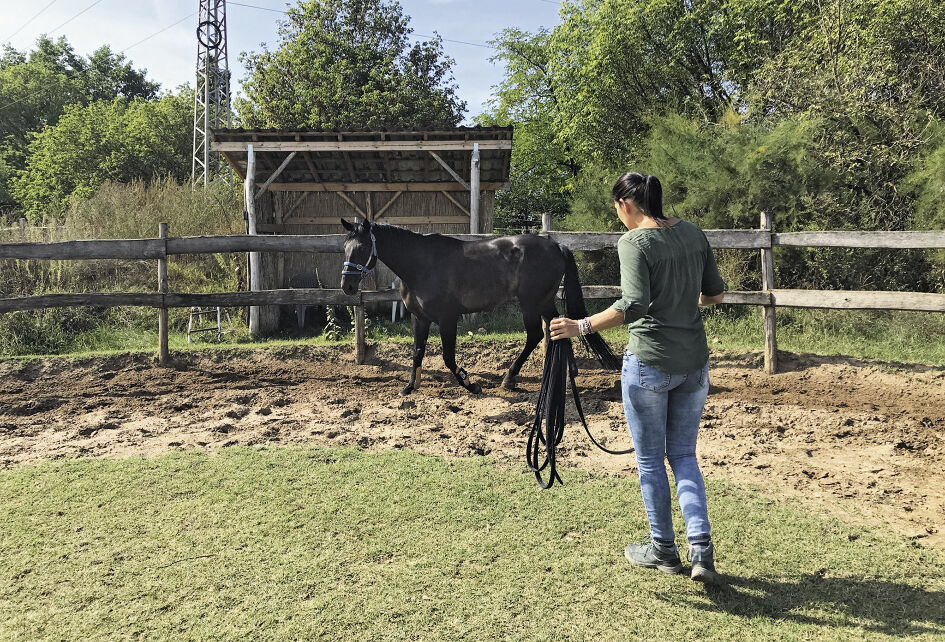There is also a lot of discussion outside among horse trainers about whether a horse should go outward or inward if we work with it freely on my lap. Like everything, it has meaning and importance.
One of the most valuable tools in the Monty Roberts method is the join, which is in short, contact with the horse. In fact, we have to train for the rest of our lives to do well.
Joining is an exercise in which we have to turn the horse at least twice. I am writing that as a minimum because there could be more rounds if connections so desired, but this article is not about that at the moment.
The point of the rounds is that the horse can observe the situation while we are with both eyes.
This is necessary because there is a small flow of information between the two hemispheres of horses – up to 20-30% – which is also due to their vision, so what they perceive with the right eye is most of the information stored only in the right hemisphere. To complete the picture, they also need to look at this situation, person or object with the left eye.
Surely every rider has already experienced, for example, taking off his coat while riding and putting it on the edge of the track and then passing it with his right hand without any problems, but as soon as he crosses his left hand, the horse pretends to see the coat first.
This is not because the horse is “ridiculous”, but because only the right side stored the image of the jacket. For this reason, on the one hand, I must show everything to both “parties”, and on the other hand, I must ask for a tour of my circle when I join.
I always strive for an outward transformation upon joining. There are several reasons for this.
The first is safety, because if the horse turns away from me, it will not even begin to move towards me. A lot of people say, “Good, yeah, but that’s how you can start.” If someone is in good shape, this cannot happen in this case. The second question is about confidence as to whether the horse would let me into the blind spot behind it for a moment. An extremely fearsome horse that had little experience with humans, or had just experienced a lot of evil, would definitely encounter him. I used to let this go the first few times, and my experience is that as confidence grows, so does the horse pull away from me. Horses who are insecure and want to take my place in the middle of my circle due to insecurity or dominance tend to turn inward and turn toward the man. This can be very dangerous. I always try to keep these horses away and don’t let me in until I’m in a summons situation. As I wrote in my previous article on the importance of eye contact (Pegasus 2022/3), I should mention here that everything is determined by body position and eye contact. So is whether the horse is going outward or inward. I would definitely like to clarify at this point.
A well-trained horse that respects one’s requests should be able to get in and out on demand, if we’re only talking about movement, but on my lap I don’t like to ask for an inward turn.
The reason for this is that if you call me a horse with my body language and then convey it, most horses will be frustrated because it is difficult for them to differentiate. I’ve met a lot of horses that came to man after the tour because of this, because he didn’t know beforehand if there would be a bio or praise to go on.
This is one of the points when joining, because it is a dialogue that has its own rules. The turns are outward, so away from the man, but when I invite them in, I invite the horse in, toward the middle of the circle. Here’s a difference that a horse can most easily explain.
But how do you actually order a turn outward? If the horse is walking on the right hand, the goal is to send the horse’s right eye so I cross the balance point, my body plane remains parallel to the horse, and I raise the running leg to aid the block and “push” the right eye away from me. This sequence of movements can be seen in Figures 1, 2 and 3.
If I don’t give enough space, the horse will accelerate due to space constraints that occur due to pressure.
If I start to back off before the turn, the horse will start to turn inward because I opened up space with my shoulders and body. This movement is shown in Figure 4.
If all my movements seem correct, but for some reason the horse starts to turn inward, I will always try to correct it so that the moment I begin to turn inward, I will return to the driving position, and then use the space to lock the horse again and be able to turn it outward. There are times when I have to slow the horse down all the way so I don’t rush into the round and run it.
In short, even from a simple ride, there can be problems when a horse approaches a man in frustration, which is easily interpreted as “trying to attack”. In such cases, if the person does not recognize the situation and does not react properly, he may develop undesirable behavior in the horse that will affect a lot of areas later.
As always, clear communication is crucial with this horse in mind.
pataki kata












































